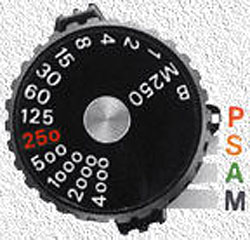Digital Photography from 20,000 Feet
by Wesley Fink on September 25, 2006 12:05 AM EST- Posted in
- Digital Camera
Shutter Speed: Stopping Motion and Controlling Light
Shutter speed is technically how long the the shutter remains open in a digital SLR or any camera. This is only theoretically the case in SLRs since a focal plane shutter uses a moving slit to expose, but it is close enough for our discussion about photo basics. There is an old rule that any photographer, even an amateur who doesn't care about understanding the process, needs to commit to memory. We will make it bold.
The fastest shutter speed you can hand hold is 1 over the focal length of the lens.
What this means is the fastest blur free picture you can shoot is at a shutter speed of one over the effective focal length of the lens. This means our 18-55mm lens, which acts like a 28-85mm lens can produce sharp pictures at 1/30 second or faster at the wide-angle end and 1/125 second and faster at the telephoto end. Some people are really good at holding a camera steady and can do better than this, but this is always a good rule of thumb.

The shutter speeds for a digital SLR are much wider than you will find on a point-and-shoot digital. Where the point-and-shoot might do 2 or 3 speeds up to 1/600s, the digital SLR offers a very wide range of shutter speeds. Most SLRs today perform over a range of about 30 seconds to 1/4000 second, and the shutter speed range is similar to ISO in that the larger the number the more light is passed. The scale is also approximately linear:
1 - 1/2 - 1/4 - 1/8 - 1/15 - 1/30 - 1/60 - 1/125 - 1/250 - 1/500 - 1/1000 - 1/2000 - 1/4000
Each value going faster passes half the light of the lower value. So 1/15s passes twice the light of 1/30s. This brings us back to the other part of why you get blurry pictures with your kit zoom lens indoors. Since the kit zoom passes 1/4 to 1/12 the light of a normal f1.7 lens, it must shoot at slower speeds (let in more light) for proper exposure. When you fall below 1/60 to 1/30s those properly exposed images will be blurry with your kit zoom.
Shutter speed is technically how long the the shutter remains open in a digital SLR or any camera. This is only theoretically the case in SLRs since a focal plane shutter uses a moving slit to expose, but it is close enough for our discussion about photo basics. There is an old rule that any photographer, even an amateur who doesn't care about understanding the process, needs to commit to memory. We will make it bold.
The fastest shutter speed you can hand hold is 1 over the focal length of the lens.
What this means is the fastest blur free picture you can shoot is at a shutter speed of one over the effective focal length of the lens. This means our 18-55mm lens, which acts like a 28-85mm lens can produce sharp pictures at 1/30 second or faster at the wide-angle end and 1/125 second and faster at the telephoto end. Some people are really good at holding a camera steady and can do better than this, but this is always a good rule of thumb.

The shutter speeds for a digital SLR are much wider than you will find on a point-and-shoot digital. Where the point-and-shoot might do 2 or 3 speeds up to 1/600s, the digital SLR offers a very wide range of shutter speeds. Most SLRs today perform over a range of about 30 seconds to 1/4000 second, and the shutter speed range is similar to ISO in that the larger the number the more light is passed. The scale is also approximately linear:
1 - 1/2 - 1/4 - 1/8 - 1/15 - 1/30 - 1/60 - 1/125 - 1/250 - 1/500 - 1/1000 - 1/2000 - 1/4000
Each value going faster passes half the light of the lower value. So 1/15s passes twice the light of 1/30s. This brings us back to the other part of why you get blurry pictures with your kit zoom lens indoors. Since the kit zoom passes 1/4 to 1/12 the light of a normal f1.7 lens, it must shoot at slower speeds (let in more light) for proper exposure. When you fall below 1/60 to 1/30s those properly exposed images will be blurry with your kit zoom.










81 Comments
View All Comments
Zaitsev - Monday, September 25, 2006 - link
That was a very interesting article. I've always wanted to learn more about cameras and photography, in the hopes of making it a hobby once the time and money is available. So thanks for explaining the background info for noobs like me :) I'll be looking forward to the rest of the series.